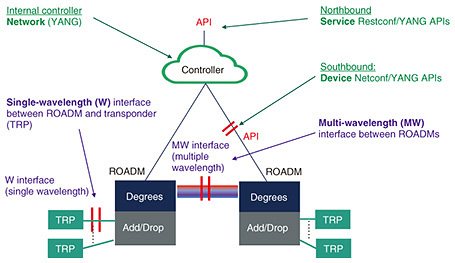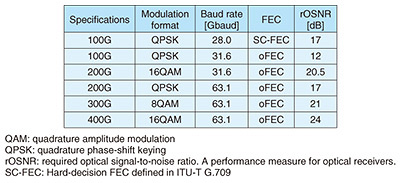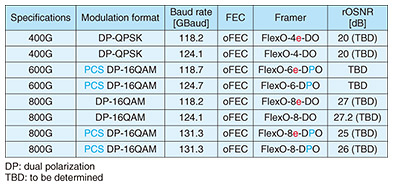 |
|||||||||||||||||||||||||||||
|
|
|||||||||||||||||||||||||||||
|
Global Standardization Activities Vol. 23, No. 8, pp. 18–22, Aug. 2025. https://doi.org/10.53829/ntr202508gls Latest Standardization in OpenROADM MSAAbstractThe OpenROADM Multi-Source Agreement (MSA) is promoting the specification of optical interface standards at the physical layer and control APIs (application programming interfaces) for equipment controllers to enable multi-vendor interoperable reconfigurable optical add/drop multiplexer (ROADM) networks in the domain of metro and long-haul wavelength-division multiplexing optical transport networks. This article introduces an overview of the standards defined by the OpenROADM MSA and its latest activities. Keywords: OpenROADM MSA, open interface, multi-vendor interoperability 1. BackgroundWith the proliferation of smartphones and the rapid advancement of artificial intelligence services, communication networks have become indispensable. For service providers, it is essential to maintain the scalability and cost efficiency of optical transport networks that support the ever-increasing communication traffic. To achieve sustainable scalability over the long term, it is also necessary to consider network architecture and ecosystem aspects [1]. Traditionally, transmission equipment and its management systems have been provided as vertically integrated solutions by a single vendor. Therefore, it was difficult to incorporate systems from other vendors once deployed, raising concerns about limited flexibility and delays in adopting new technologies. To overcome these challenges and foster a competitive and rational market environment, it is crucial to have an open architecture that supports multi-vendor interoperability. On the basis of the background above, the importance of open standardization enabling multi-vendor optical networks has been increasing. Multiple standardization bodies and forums, such as the International Telecommunication Union - Telecommunication Standardization Sector (ITU-T) [2], IOWN Global Forum (IOWN GF) [3], and Telecom Infra Project (TIP) [4], are leading related initiatives. The OpenROADM Multi-Source Agreement (MSA) [5] is one of the key forums in the optical communications field, offering open and interoperable specifications for metro dense wavelength-division multiplexing (DWDM) optical transport networks. 2. Standard specifications of OpenROADM MSAThe OpenROADM MSA formulates interoperable interface specifications for open and flexible reconfigurable optical add/drop multiplexer (ROADM) networks and aims to build an open optical networking ecosystem. Since its launch in 2016, the MSA has 32 member organizations as of April 2025, including 15 operators and 17 optical-communication-equipment vendors. The goal of the OpenROADM MSA is to define open standard interfaces that avoid vendor lock-in caused by vertically integrated systems—an issue with traditional carrier networks—and achieve open and flexible networks. Figure 1 illustrates the ROADM network configuration and interface definitions envisioned by the OpenROADM MSA.
The interoperability specifications defined by the MSA include optical transmission interfaces for the physical layer and application programming interfaces (APIs) for equipment controllers. These specifications are published by the MSA. Optical interface specifications are available in spreadsheet format on the OpenROADM website. API definitions are provided on the OpenROADM GitHub repository [6] using the Yet Another Next Generation (YANG) mode*1. A white paper outlining implementation guidelines for the API model is also available on the website.
3. Optical interface specificationsThe physical layer specifications define several functional blocks and their interfaces, including a ROADM, Xponder (transponder, multiplexer-ponder, and switch-ponder), and in-line amplifier (ILA). The optical WDM transmission signal between a ROADM and ILA is defined as the multi-wavelength (MW) interface. The single-wavelength optical interface between an Xponder and the ROADM add/drop function is referred to as the wavelength (W) interface. Table 1 presents the W interface specification released in 2022 (Optical Interface Specification Ver. 5.1). The OpenROADM MSA developed these specifications using a standardized soft-decision forward error correction (FEC) scheme called open FEC (oFEC)*2 for metro DWDM applications, Ver. 5.1 of which includes 30 Gbaud for 100- and 200-Gbit/s transmission and 63.1 Gbaud for 200-, 300-, and 400-Gbit/s transmission. These interface specifications use various modulation formats to achieve multiple rates and reach options suitable for metro optical WDM transmission.
The OpenROADM MSA is currently working on specifications for beyond 400-Gbit/s systems, with a provisional version published as Optical Interface Specification Ver. 8.0. Table 2 summarizes the content.
In the beyond 400-Gbit/s specifications, the OpenROADM MSA became the first in the industry to standardize the interoperable probabilistic constellation shaping (PCS) scheme, released as W-Port Digital Specification Ver. 6.0. PCS is applied to 600- and 800-Gbit/s specifications. In addition to the standard Optical Transport Network (OTN) framer, the beyond 400-Gbit/s specification introduces the Ethernet-optimized framer. As shown in Table 2, FlexO-n-e refers to the Ethernet-optimized framer, while FlexO-n refers to the standard OTN framer. The Ethernet-optimized framer operates at a slightly lower baud rate than OTN framers, reduces frame overhead by minimizing management features, thus achieving higher transmission performance and lower power consumption. These specifications have been shared via liaisons with other standardization bodies such as ITU-T and expected to be widely adopted.
4. API specifications for equipment controllersFor equipment controller specifications, the OpenROADM MSA defines three categories of YANG models for its controller APIs: service, network, and device. (1) Service model Defines the northbound interface for responding to service requests from higher-level operation systems. It specifies the set of parameters required to provide services. (2) Network model Abstracts physical-layer equipment information and manages it as topology information. This enables minimized impact on higher layers during equipment replacement. It expresses inter-device connectivity, resource availability, and functional constraints that are referenced when determining the wavelength service paths across a ROADM network. (3) Device model A template for managing device parameters, supporting plug-and-play functionality. It allows for flexible management of multiple line cards and pluggable modules such as CFP2-DCO (C form-factor pluggable digital coherent optics) inserted into equipment chassis. YANG model Ver. 7.1 is a commercially deployable specification that supports 400G systems and has been implemented in multi-vendor commercial systems. While this version supports functionalities for commercial operation, the YANG model continues to be enhanced to address new use cases and emerging physical layer specifications. As of April 2025, the latest release is Ver. 17.0. One example of newly added flexible control features is the ability to manage “bookend connections,” which is an interworking with non-OpenROADM-compliant transponders. Work is also underway on YANG model specifications to manage systems that use both the C-band*3 and L-band*4, beyond the traditionally assumed C-band-only configurations.
5. Collaboration with other standardization bodiesThe OpenROADM MSA actively collaborates with other standardization and open forums. One notable example is its cooperation with IOWN GF, with which a liaison relationship has been established. IOWN GF has adopted OpenROADM MSA specifications as part of its Open All-Photonics Network (Open APN) functional architecture [7]. It has also identified additional functions that OpenROADM MSA should expand to meet Open APN requirements. On the basis of this, the OpenROADM MSA worked with IOWN GF members to extend its specifications to support optical wavelength connections between user premises, which is a core requirement of Open APN [8]. Specifically, it defined a remote transponder control architecture that enables an Xponder located at a user site to be controlled via an optical supervisory control channel that shares the same fiber as the main signal. A new single-wavelength optical interface specification (W’ interface) was also introduced, and Optical Specification Ver. 7.0 reflecting this was published in April 2024. Previously, optical wavelength connections between Xponders under the same ROADM device were not permitted. To permit this, the MSA added a “turn-back” function to the controller API specification and published Device Model Ver. 13.0 in March 2023. The OpenROADM system has been widely implemented in commercial products, and numerous multi-vendor interoperability demonstrations have been conducted by OpenLab@UT Dallas, which maintains close ties with the OpenROADM MSA [9]. Joint demonstrations with IOWN GF have also been showcased at the Optical Fiber Communication Conference and Exhibition (OFC) 2024 and are planned for OFC 2025, involving multiple companies [10]. The collaboration between IOWN GF and OpenROADM MSA specifications is accelerating the evolution of Open APN architectures sought by operators. 6. ConclusionThe OpenROADM MSA is an open forum that defines interoperable specifications for metro and long-haul DWDM optical networks. It specifies both physical-layer optical interface standards from 100G to 800G and YANG models for equipment controller APIs. These specifications are being implemented by multiple vendors and have demonstrated interoperability through industry exhibitions. The OpenROADM MSA is expected to continue contributing to the establishment of an open ecosystem in the optical networking domain through collaboration with other open forums. References
|
|||||||||||||||||||||||||||||







